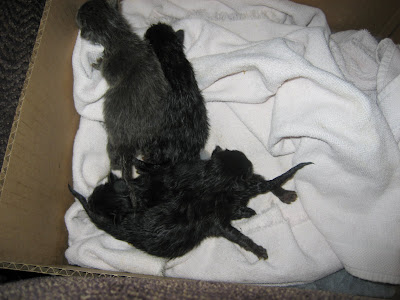
Time to reveal the reason I haven't been on in a couple of days. As you can see, I've got kittens. Various neighbours have come and gone from the neighbourhood in recent years and left their cats behind- unspayed and unneutered, of course. We (a couple of owners and our building caretakers) have adopted a small colony of feral cats that live at our apartment building now. We feed them and take care of them the best we can; but, these cats are truly feral and will not let a human anywhere near them. Our female (probably the most feral) became pregnant again; so, we tried to trap her. The idea was that we were going to keep her and her kittens in my den until the babies were able to leave mom. After this litter, we were going to get her spayed to prevent anything like this happening again.
Unfortunately, before we could get her safely trapped, she had her babies either Monday night or Tuesday morning. She is very trap savvy. She chose an outside stairwell and the babies were deposited on the cold concrete. It is autumn here in Surrey, BC and the babies could not live on the concrete - much too cold - so we took them and tried to lure mommy in so she could nurse them in warmth with a full tummy. I am sorry to report that mom has disappeared and we are unable to find her (although we continue to look).
I have been on kitten duty since Monday - nursing every two hours - day and night. I have also been on laundry duty (they manage to excrete alot considering their size) and stimulation duty three times a day. Kittens must be massaged all over including those regions to encourage elimination and development of inner organs. Needless to say, any time I have had to myself, I have used to sleep after I have taken care of my own pets.
In the above pictures, the babes are three (exhausting) days old. As a society we are still not very evolved when it comes to recognizing the rights of other sentient beings on our planet. Animals are treated like property without feelings and it must stop. The number of feral cats, in particular, forced to fend for themselves is growing at an alarming rate. They continue having kittens that repeat the cycle of miserable lives leading to miserable deaths since these poor things are put out without being spayed or neutered.
Our mother cat originally had 5 kittens; but, one of them had been too badly chilled on the concrete to survive. If we hadn't found them when we did, he would died an agonizing death freezing to death. As it was, he died on my chest being held close for warmth and stroked with love and caring. Most feral cats don't have the luxury of such a death. Theirs is painful and lonely.
We have found homes for all 4 babies and they will be with their new families just in time for Christmas. A heartwarming end to a heartbreaking story. Unfortunately, the ending is usually as heartbreaking as the story.
Please spay and neuter your pets. Remember outdoor pets live shorter lives and can be victims of cars, coyotes, practical jokes, and many other cruel acts. Get involved with an animal rescue if you have the inclination. Donate to a rescue if you have the resources; but, remember that they always need things like old towels, an extra can or two of food, a toy your pet doesn't play with anymore. Before you throw it out, see if a rescue could use it. It only takes a moment to drop these things off and your local pet store usually collects such donations. There are sites on the internet - see thehungersite.com on the right-hand side of my blog - to donate free food to rescued animals just for clicking.

As you can see from the above picture, little voices are calling me and little bodies are on the move in search of food. The final four have hearty appetites and no trouble letting me know when meal time is here!!
After I answer the call and get everyone tucked in for the night with full tummies and empty bladders and bowels, I will be getting a few more hours sleep. I will keep you updated on the remaining 3 females and 1 male. I'm sure there will be many antics before they go to their forever homes.
Meow!!















